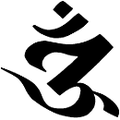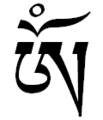Om



Om vel auṃ (Devanagari ॐ) in religionibus Indiae est sonus sacer, mantra, et signum spirituale. In Hinduismo significat necessariam ultimae realitatis conscientiaeve partem, Atman appellatam.[3][4][5] Qui sonus sensu lato est syllaba quae libere aut ante recitationem spiritualem in Hinduismo, Buddhismo, et Iainismo cantatur.[6][7] Significationes connotationesque sonorum om inter varias scholas intra et trans varias traditiones variant. Om est elementum ex iconographia in manuscriptis, templis, monasteriis, et recessibus spiritualibus antiquis et mediaevalibus in Hinduismo, Buddhismo, et Iainismo inventa.[8][9]
Syllaba om etiam appellatur onkara (ओङ्कार, oṅkāra), omkara (ओंकार, oṃkāra), et pranava (प्रणव, praṇava).[10][11]
Pinacotheca
[recensere | fontem recensere]Fortuna hodierna
[recensere | fontem recensere]Ligatura om in scripto Brahmico late in contracultura Occidentali ex annis 1960 agnoscitur, plerumque in forma Devanagari normativa (ॐ) scripta, sed om in scripturá Tibetaná (ༀ) aliquando in culturá vernaculari videtur.[12] In musica, hoc signum in 3, tertio gregis Soulfly albo musico, monstratur.[13]
Nexus interni
Notae
[recensere | fontem recensere]- ↑ John A. Grimes (1995). Ganapati: Song of the Self. State University of New York Press. pp. 77–78. ISBN 978-0-7914-2439-1.
- ↑ Stephen Alter (2004), Elephas Maximus (Penguin, ISBN 978-0143031741), 95.
- ↑ James Lochtefeld (2002), "Om," The Illustrated Encyclopedia of Hinduism, vol. 2: N-Z (Rosen Publishing, ISBN 978-0823931804), 482.
- ↑ Barbara A. Holdrege (1996). Veda and Torah: Transcending the Textuality of Scripture. SUNY Press. p. 57. ISBN 978-0-7914-1640-2
- ↑ "Om". Merriam-Webster (2013), Pronounced: \ˈōm\
- ↑ Jan Gonda (1963), "The Indian Mantra, Oriens.16: 244–297.
- ↑ Julius Lipner (2010), Hindus: Their Religious Beliefs and Practices (Routledge, ISBN 978-0415456760), 66–67.
- ↑ T. A. Gopinatha Rao (1993), Elements of Hindu Iconography, vol. 2 (Motilal Banarsidass, ISBN 978-8120808775), p. 248
- ↑ Sehdev Kumar (2001), A Thousand Petalled Lotus: Jain Temples of Rajasthan (ISBN 978-8170173489), p. 5.
- ↑ Nityanand Misra (25 July 2018). The Om Mala: Meanings of the Mystic Sound. Bloomsbury Publishing. pp. 104–. ISBN 978-93-87471-85-6
- ↑ "OM". Sanskrit English Dictionary, University of Köln, Germany
- ↑ Messerle, Ulrich. "Graphics of the Sacred Symbol OM".
- ↑ Image: 400x400.jpg, (400 × 400 px) – Soulfly 3 cover art. . nuclearblast.de
Bibliographia
[recensere | fontem recensere]- Ayer, V. A. K. 1998. Hindu Sastras and Samskaras. Mumbai: Bharatiya Vidya Bhavan. Bhavan's book university 209 ZDB-ID 1035578-9.
- Swāhānanda. 1983. Hindu Symbology and other Essays. Madras: Sri Ramakrishna Math.
- von Glasenapp, Helmuth. 1999. Jainism: An Indian Religion of Salvation. Dellii: Motilal Banarsidass. ISBN 81-208-1376-6. Google Books. Theodisce: Der Jainismus: Eine Indische Erlosungsreligion, conv. Shridhar B. Shrotri.
- Zimmer, Heinrich. 1973. Philosophie und Religion Indiens. Francofurti: Suhrkamp. ISBN 3-518-07626-4. Suhrkamp-taschenbücher wissenschaft 26.
Nexus externi
[recensere | fontem recensere]| Vicicitatio habet citationes quae ad Om spectant. |
| Vicimedia Communia plura habent quae ad om spectant. |
- Wiktionary entry: "ॐ"
- Gyatso, Tenzin, Dalai Lama. "On the meaning of: OM MANI PADME HUM: The jewel is in the lotus or praise to the jewel in the lotus." Commentarius ex acrosai transcriptus,
- Stein, Joen. "Just say Om." Time Magazine Archives.
- Kumar, S., H. Nagendra, N. Manjunath, K. Naveen, et S. Telles. 2010. "Meditation on OM: Relevance from ancient texts and contemporary science." International Journal of Yoga 3 (1): 2–5. PMC 2952121.. PMID 20948894. doi:10.4103/0973-6131.66771.
- Telles et al. 1995. "Autonomic changes during "OM" meditation."
- Francke, A. H. 1915. "The Meaning of the 'Om-mani-padme-hum' Formula." The Journal of the Royal Asiatic Society of Great Britain and Ireland 397–404. JSTOR 25189337. doi:10.1017/S0035869X00048425.
- Kumar, Uttam, Anupam Guleria, et Chunni Lal Khetrapal. 2015. "Neuro-cognitive aspects of 'OM' sound/syllable perception: A functional neuroimaging study." Cognition and Emotion 29 (3): 432–41. doi:10.1080/02699931.2014.917609. PMID 24845107.














